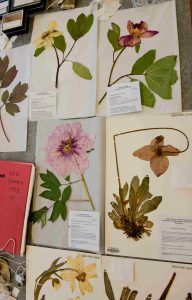 Zoë Goodwin, who first arrived at RBGE as an MSc student, became a member of staff, and is now a PhD student (University of Oxford), has just published a paper on misidentifications: “Widespread mistaken identity in tropical plant collections“
Zoë Goodwin, who first arrived at RBGE as an MSc student, became a member of staff, and is now a PhD student (University of Oxford), has just published a paper on misidentifications: “Widespread mistaken identity in tropical plant collections“
In that paper two world-wide phenomena are quantified:
- In large tropical plant groups most of the specimens in that group are unlikely to have the correct name unless the whole group has recently been revised by an expert.
- The number of herbarium specimens worldwide is increasing exponentially.
If you had asked me, before Zoë’s study, what percentage of collections had the wrong name in the herbarium I might have guessed it was about 20%, now I am sure it is well over half.
That will not be the case for some groups: the specimens from Britain and Ireland will mostly have the correct name. Similarly the folders from areas where there has been a recent Flora written by botanists based in Edinburgh will contain a high proportion of specimens with the correct name. The plants of Turkey, Bhutan, Nepal, Chile, the Arabian Peninsula and Soqotra may need some updating but for the most part they are internationally important collections with a high proportion of names following the latest taxonomy. Certain groups such as conifers, Rhododendron, Begonia, Gesneriaceae, Zingiberaceae and Sapotaceae will also be well named, due to the years of in-house taxonomists and visiting experts checking them. But apart from the other groups for which an expert has seen all the specimens – and perhaps the specimens from the living collection at RBGE – the rest have less than a 50% chance of having the correct name.
So how does that make me feel? Isn’t it my job as the curator to make sure the specimens have the right name?
That is a common misconception: “large natural history collections have to have the most up-to-date name to be useful”. Not at all! The real function of these collections is to allow specialists to generate the most up-to-date names and understanding of plants for society. Lots of unnamed specimens in the herbarium mean lots of new information. The specimens are there to be identified, renamed, analysed and synthesised to give us new and better knowledge of our green planet.
In addition – given the dynamic nature of our understanding of plants and fungi in so many parts of the world, it would be a waste of time for a curator to try to name 3 million specimens. Our job as curators is instead to make sure the specimens are in the right family and the right genus so that when the expert wants to consult them she or he can find them.
There is one task we curators need to allocate more time to, taking recent monographs and revisions and to update specimen names from those publications, if the specimens in our herbarium were not annotated by the taxonomists who wrote the books.
Give me your misidentified, your undetermined, your piled masses of specimens yearning to be named (with apologies to Emma Lazarus) – we will put you in the cupboards and have you waiting and ready for the next specialist to work on you.
